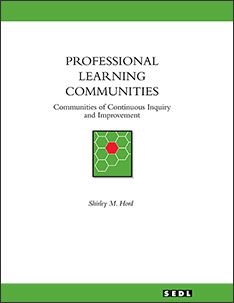Introduction
The term learning community is becoming well integrated into the lexicon of American education. Some educators see it as extending classroom practice into the community, utilizing community resources, both material and human. For others, it suggests bringing community personnel into the school to enhance the curriculum and learning tasks for students. For still others, it means having students, teachers, and administrators reciprocally engaged in learning.
Astuto, et al. (1993) proposed three related communities: (1) the professional community of educators, (2) learning communities of teachers and students (and among students) both within and outside the classroom, and (3) the stakeholder community. This paper focuses on what Astuto and colleagues labeled the professional community of learners, in which the teachers in a school and its administrators continuously seek and share learning, and act on their learning. The goal of their actions is to enhance their effectiveness as professionals for the students' benefit; thus, this arrangement may also be termed communities of continuous inquiry and improvement.
Through a review of the literature, this paper will explore the concept and operationalization of professional learning communities:
- What do professional learning communities look like and how do they function?
- Why are such learning communities important for both staff and students?
- How are learning communities introduced and developed in schools as a new organizational arrangement?
The reader should be aware that the literature selected for this report consists primarily of items that focus on building learning communities of entire school staffs or whole high school departments. MacMullen, in a review and analysis of factors influencing Coalition of Essential Schools reform (1996), concluded that a significant requirement for impact is the inclusion of the whole faculty (emphasis added): in developing the vision, understanding the mission and purpose for which they are engaging, and deciding how to carry out their reform plans. Similarly, in their article "Learning From School Restructuring," Peterson, McCarthey, and Elmore (1996) found that successful school restructuring involved teachers' meeting together as a whole staff or in teams.
A focus on the system or the group as a whole does not, however, mean that the individual should be ignored, for, as Hall and Hord (1987) emphasized, organizations do not change - individuals do. Fullan agreed that it is the individual who provides the most effective route for accomplishing systemic change (1993); individuals change systems, acting separately and together (1994).
Next Page: The Learning Community Evolves

